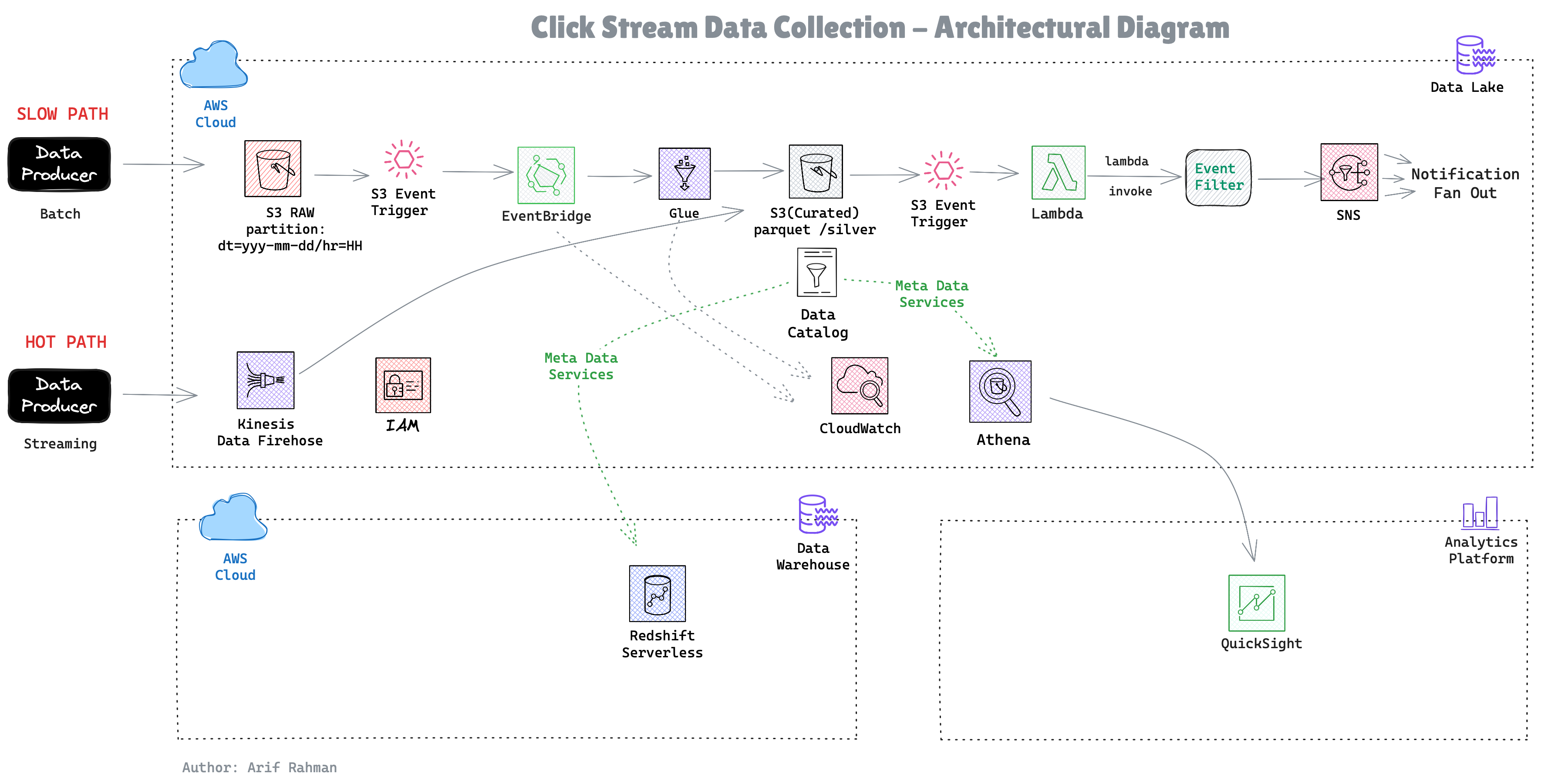Building a Production-Ready Data Pipeline on AWS: A Practical Guide
How we built a scalable clickstream analytics pipeline that processes 500GB/day while cutting costs by 70%


The components:
Storage: S3 as the data lake foundation
Cataloging: Glue Data Catalog for metadata
Processing: Glue ETL for transformations
Analytics: Redshift for BI, Athena for ad-hoc queries
Events: EventBridge + Lambda for real-time alerting
Let's dive into each piece and the decisions that shaped them.
How we built a scalable clickstream analytics pipeline that processes 500GB/day while cutting costs by 70%
You're a data engineer at a growing e-commerce company. Every hour, your web application generates millions of clickstream events—page views, add-to-carts, purchases. These land as JSON files in S3, and your business teams are demanding:
Sound familiar? Let me show you how we solved this with a modern AWS data pipeline.
Our solution follows a medallion architecture with four distinct layers:
The components:
Let's dive into each piece and the decisions that shaped them.
Raw data arrives at:
This year/month/day/hour structure isn't arbitrary—it's our first line of cost defense.
Why it matters:
Athena charges $5 per TB scanned. Without partitioning, querying one day of data means scanning the entire dataset. With partitioning, we scan only what we need:
95% cost reduction with one WHERE clause. That's the power of partitioning.
Instead of running crawlers or MSCK REPAIR TABLE to discover partitions, we use partition projection:
Now Athena automatically knows where to find data. No maintenance, zero lag. New files are immediately queryable.
We transform raw JSON into a star schema with fact_clicks and dim_users. Here's why:
The star schema advantage:
Compared to alternatives:
Our workload is 95% reads, 5% writes. Star schema optimizes for the common case.
Our Glue job does three critical things:
Data Quality Checks
Create Dimension Table (SCD Type 1)
Build Fact Table with Metrics
Output: Parquet files with Snappy compression. Why Parquet?
One query that convinced us:
Here's our controversial decision: We use both Redshift AND Athena.
Hot Data (0-30 days) → Redshift:
Warm Data (30-90 days) → Redshift Spectrum:
Cold Data (90+ days) → S3 Glacier:
Query pattern analysis:
We optimized for the 80% case and made the 5% case acceptable.
Before optimization (all in Redshift):
After optimization (hybrid):
Savings: $7,698/month (82%)
Business requirement: "Alert us immediately when someone makes a $1,000+ purchase."
Our solution: EventBridge + Lambda
Kinesis would give us true streaming, but:
Lambda gives us:
Simple, effective, and costs pennies.
Our initial architecture was expensive:
What we changed:
Redshift Reserved Instances (75% savings)
S3 Intelligent-Tiering (35% savings)
Glue Job Bookmarks (30% time savings)
Redshift Auto-Pause (Dev/Test)
Total savings: $7,000/month = $84,000/year
Start Simple, Optimize Later
We launched with:
This got us to production in 3 weeks. We added:
Partition Everything
Every table is partitioned by date. This single decision:
Measure Before Optimizing
We logged every query's execution time and scanned bytes. This data revealed:
Implement Data Quality Earlier
We had to backfill 2 weeks of data due to a schema mismatch. A simple validation would have caught it:
Use Terraform from the Start
We manually created resources initially. Big mistake. When we needed to replicate to staging, it took 2 days to document everything.
Now everything is code:
Spinning up new environments: terraform apply -var-file=staging.tfvars
Monitor Data Freshness
We once didn't notice data wasn't arriving for 6 hours. Now we have:
Alarm fires if lag > 90 minutes.
Before optimization:
After optimization:
Changes made:
Result: 37x faster, 90% less data scanned
Our most common query:
We materialized it:
Impact:
Layer 1: Network
Layer 2: Identity
Layer 3: Data
Layer 4: Audit
Handling deletion requests:
Challenge: Parquet is immutable. We have to rewrite entire partitions. For frequent deletions, consider Apache Iceberg or Delta Lake.
We track 5 key metrics:
Data Freshness
Current Time - Latest Partition Timestamp < 90 minutes ✓
ETL Success Rate
Successful Runs / Total Runs > 99.5% ✓
Query Performance (P95)
95th Percentile Query Duration < 5 seconds ✓
Cost per TB Processed
Monthly Cost / TB Processed < $50 ✓
Data Quality Score
Valid Records / Total Records > 95% ✓
Critical Alarms (page on-call):
ETL job failed
Data not arriving (90+ minute lag)
Redshift cluster unhealthy
Warning Alarms (Slack notification):
Query duration > P95 baseline
Cost spike (>20% daily budget)
Data quality score < 95%
Benefits:
Building a production data pipeline isn't about using the fanciest tools—it's about making smart trade-offs:
Serverless over self-managed (unless you have specific needs)
Partition everything (it's free performance)
Optimize for the common case (80/20 rule applies to data too)
Monitor what matters (data freshness > vanity metrics)
Start simple, iterate (perfect is the enemy of shipped)
Before:
Manual data exports for analysts
Week-old analytics
$15,000/month AWS bill
2 engineers full-time on data ops
After:
ROI: $143,000/year savings + countless analyst hours
Code:
https://gitlab.com/arif-rahman4/mini-data-pipeline
Questions? Reach out on https://www.linkedin.com/in/arif-rahman-da/
Tags: #DataEngineering #AWS #Analytics #BigData #CloudComputing
Written by Data Engineering
Senior engineer with expertise in data engineering. Passionate about building scalable systems and sharing knowledge with the engineering community.
Related Articles
Continue reading about data engineering

Building a 90-Second Credit Card Approval System: A Real-Time Architecture Case Study
How we designed a production-grade, event-driven approval pipeline that processes credit applications in under 90 seconds while maintaining 99.9% reliability

Built an architecture for instant approvals backend
Designed an architecture that makes intelligent decisions in milliseconds - perfect for fraud detection, approvals, and access control.

How to Turn Your Data Into a Revenue Engine
How to Turn Your Data Into a Revenue Engine
Stay Ahead of the Curve
Get weekly insights on data engineering, AI, and cloud architecture
Join 1,000+ senior engineers who trust our technical content
